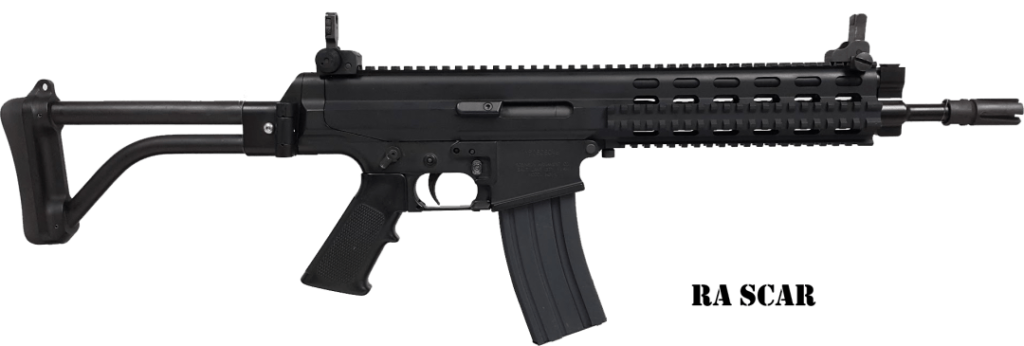
The XCR-L is 12 years old this year! Over the years, the XCR has been sold in many different configurations. It was originally designed for the Special Forces Combat Assault Rifle (SCAR) Program. Above is an image of one of Robinson Armament’s SCAR rifle samples submitted for the SCAR trials but was never tested because of government corruption. There have been changes to some parts over the years. This page of our website helps you identify the parts you have so that you can order the correct replacement parts or Caliber Conversion Kits. The XCR was so well designed in the beginning that even the oldest XCR can be upgraded to have all the features of our most current models.
The XCR-M was developed later and has not changed much. Therefore, pictures of the XCR-M parts do not appear below but at the end, there is a link to the XCR-M Part List.
You can purchase most parts directly from us via our XCR PARTS webpage. If you have any questions whatsoever, don’t hesitate to CONTACT us.
XCR-L LOWER RECEIVERS
There have been some modifications to the XCR-L Lower receivers. Below you can find and identify those changes
Bolt Catch
One of the items that has changed is the Bolt Catch.
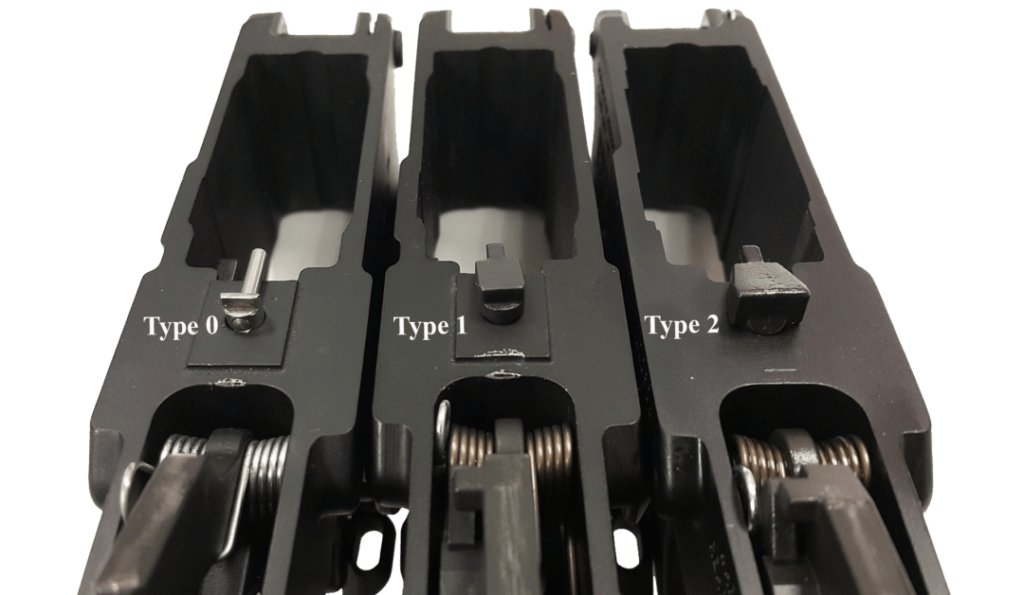
As you can see from the image above, there are three different Bolt Catches – Type 0, Type 1, and Type 2. The Types 0 & 1 are interchangeable (Note: The Type 0 is no longer produced.) XCR-L Lower Receivers that accept the Type 0 and Type 1 can easily be identified by the raised, rectangular surface just below the Bolt Catch. The Type 2 Bolt Catch will not work in Lower Receivers with the raised, rectangular surface and the Type 0 & 1 Bolt Catches will not work in Lower Receivers without the raised, rectangular surface. The Type 2 Bolt Catch is the same Bolt Catch used in the XCR-M Lower Receiver.
Magazine Release
There are two types of Magazine Releases – Type 1 and Type 2. Receivers that accept the Type 1 Magazine Release can be identified as having a flat front edge while the Type 2 have a rounded front edge. Please refer to the images below.

Receiver Rear
There are three different rear portions on the XCR-L – Type 1, Type 1 Modified, and Type 2.
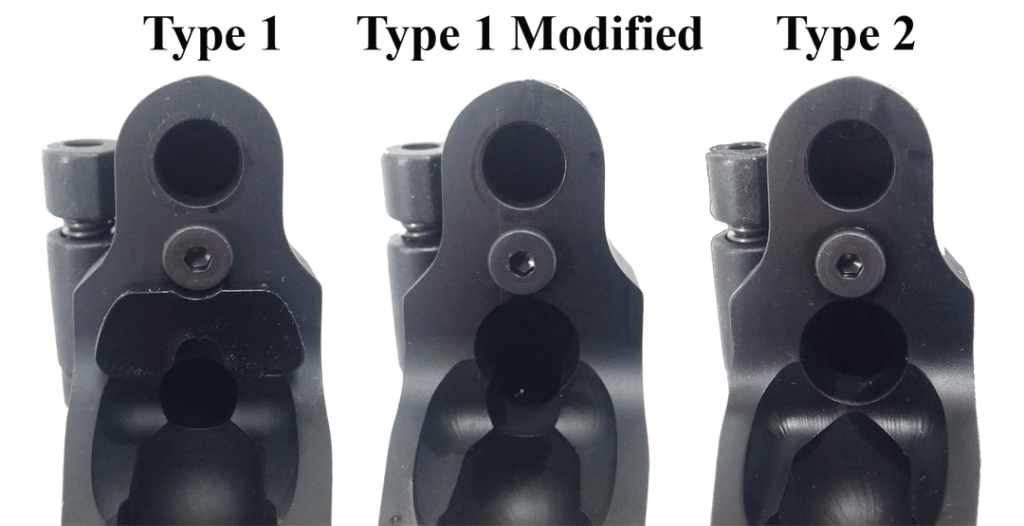
You will notice that the Type 1, has a Recoil Buffer while the Type 1 Modified and Type 2 do not. The Type 1 has a smaller hole which was made to work with a Type 1 Bolt and Carrier (more about these will be discussed below.). The Type 1 Modified is a Type 1 that has been modified to use the Type 2 Bolt and Carrier which has its own Recoil Buffer built in. Of course, a Type 2 is also designed to work with a Type 2 Bolt and Carrier.
Please note that a XCR-L Type 1 Lower Receiver can be modified to a Type 1 Modified Lower Receiver for a reasonable charge if sent to our facility.
Fire Control Parts
There are two different Sets of fire control parts for the XCR-L – Type 1 and Type 2.

It is easy to determine which Fire Control parts you have by unloading the firearm, aiming it in a safe direction, pulling the trigger, and then separating the Upper Receiver and Lower Receivers. Viewing the Lower Receiver from the left hand side, you will notice that the Hammer of the Type 1 Fire Control parts has a single rather large protrusion on the left side. You will notice that the Hammer of the Type 2 Fire Control parts has two protrusions on its left side – a larger one and a smaller one. You will also notice that the Safety Selector of the Type 1 and Type 2 Fire Control parts is different.
The Type 2 Fire Control parts have a superior feel and trigger pull. These parts will fit in all XCR-L and XCR-M models. They can be purchased directly from the Company. If you like, we can install them for a small fee if you return your lower receiver to us.
XCR-L BOLT AND CARRIER
XCR-L Bolt
There are three different Types of XCR-L Bolts – Type 0, Type 1, and Type 2. There are two different types of XCR-L Carriers.
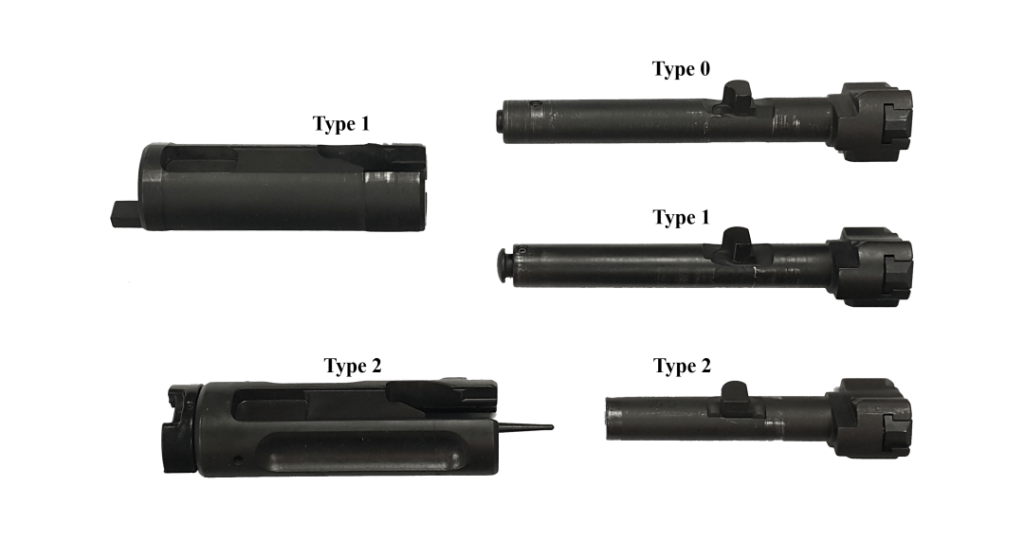
As you can see from the images above, the Type 0 has a very small Firing Pin head sticking out the back of the Bolt. The Type 1 has a larger Firing Pin head. The Type 2 Bolt does not have a Firing Pin contained in the Bolt; the Firing Pin is contained in the Type 2 Carrier. The Type 1 Carrier can be identified by the small tail sticking out its back. The Type 2 Carrier contains the Recoil buffer on its rear side.
The Type 2 Bolt and Carrier is an improved system. All XCR-Ls can be upgraded to use the Type 2 Bolt and Carrier by modifying the Type 1 Lower Receiver to be a Type 1 Modified Lower Receiver as shown above. Contact us for more information.
XCR-L Extractor
The XCR-L Extractors are number have a number on the front. 5 is for 5.56, 6 is for 6.8, 7 is for 7.62×39, 3 is for .308. The 5.56 Extractor is also used for .300 Blackout and 5.45×39. The 7.62×39 extractor is also used for 6.5 Grendel. In 2016, we came up with a newer 5.56 Extractor which improves extraction. It should be used with the Omni Deflector mentioned lower on this page.
XCR Extractor Spring
There has been a change to the XCR-L and XCR-M Extractor Spring. Please note that the images below appear much larger than the actual extractor springs which are only about .5″ long.
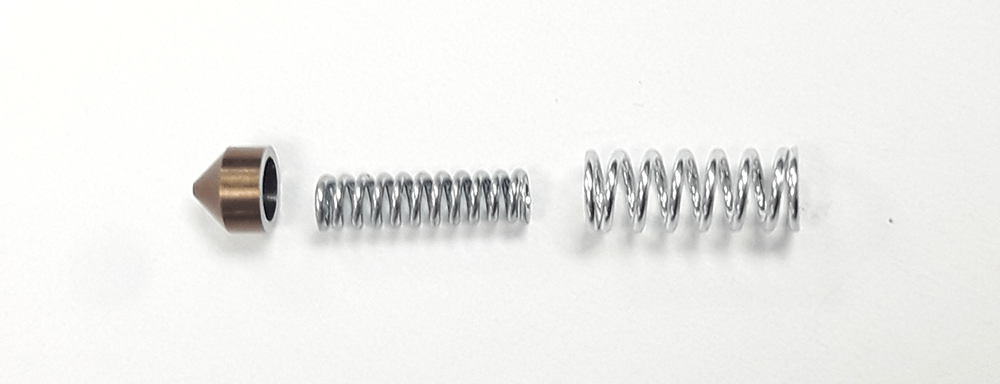
The black and orange polymer springs have been replaced by two metal springs and a shorter detent as shown in the images above. The smaller spring goes inside the larger spring.
XCR-L OPERATING SYSTEM
The XCR-L can use four different types of operating systems – Type 0, Type 1, Type 2, and Type 3. We define the Operating System as the parts that cause the firearm to cycle (move). These parts consist of three Parts: the Gas Block, the Operating Rod (Oprod), and the Gas Tube.
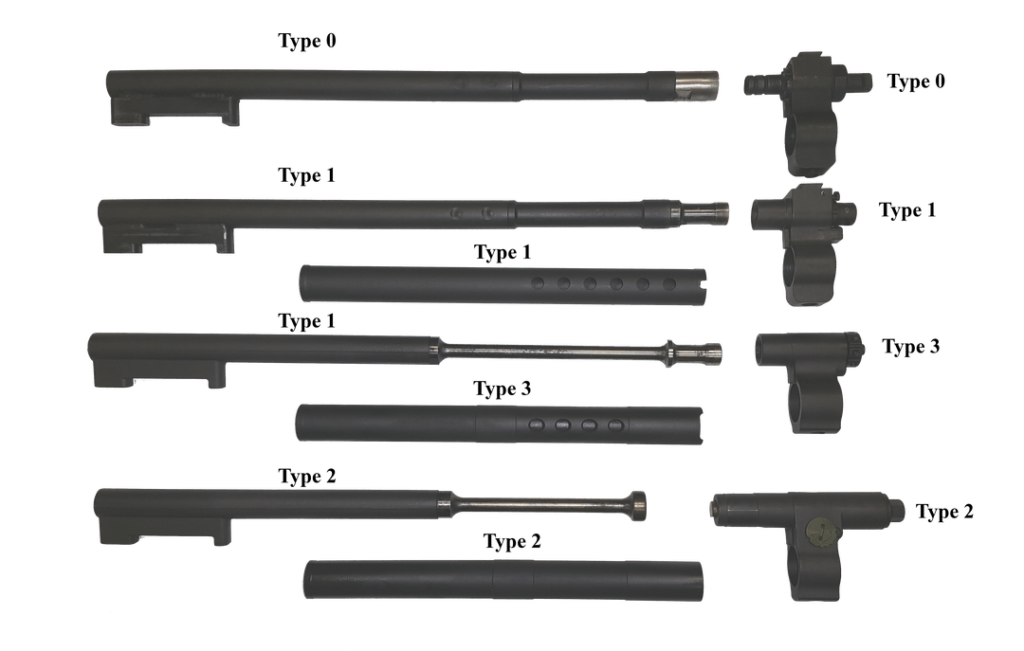
The Type 0 Operating System (OS) is found only on the earliest XCR-Ls. It was discontinued because it was found that it did not cycle reliably when using calibers other than 5.56. The Type 0 gas block required a wrench to adjust the gas settings.
The Type 1 OS is found on most XCR-Ls. It has a gas adjustment dial on the Gas Block that has 5 positions – S through 4. There have been 2 variations of the Operating Rod (Oprod) using in the Type 1 OS. The Type 1 Oprod on top had a chamber behind the piston head which held some brass anti-bounce weights. These weights were found to be unnecessary and can be removed. Both of the Type 1 Oprods are interchangeable. The Type 1 Gas Tube has holes and a small notch on one side.
The Type 2 OS is almost identical to that found on the XCR-M MWS. It is a gas cut off system similar to that found on the M14 rifle. It has several gas adjustment settings. The Type 2 Gas Tube has no holes and no notches.
The Type 3 OS has a Gas Block with an 8 position gas adjustment dial – 0 through 8. It uses the Type 1 Oprod, but uses a Type 3 Gas Tube which has holes and a wider notch on one side. The Type 3 OS was designed for use on XCR-L Upper Receivers which require the Gas Block to be contained inside the Upper Receiver. The Type 3 OS can be used on any XCR-L.
There is much discussion on the web about advantages and disadvantages of a Long Stroke (Types 1 & 3) vs. a Short Stroke (Type 2). The fact is both work very well and a lengthy discussion here is not warranted.
It should be here noted that the images above are all of our Standard length OS. There are 4 different lengths that have 4 different length piston heads or extensions on the their Oprods and different length Gas Tubes. These OS lengths from longest to shortest are: Standard, Mini, Blackout, and Micro.
A link to the XCR- L price list can be found below.
XCR-M PARTS
There have not been many changes to the XCR-M platform. However, there are a few which improve the accuracy. Please refer to the image below.
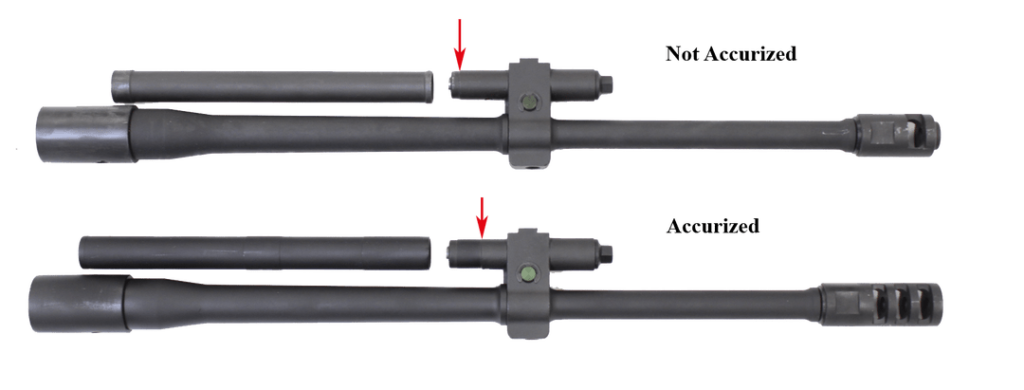
The accuracy enhancement consists of a modified gas block, a new gas tube, and a new muzzle brake. Additionally, a barrel with a special chamber is used. This chamber is compatible with .308 and 7.62 NATO ammunition. These barrels are Marked as “.308 M 1/10”. All new XCR-Ms are shipped with these enhancements. These enhancements can be made to any XCR-M. Contact us for information and pricing.
XCR STOCKS
There are now three XCR Stocks – the FAST 1, FAST 2 and FAST 3. Please refer to the images below.
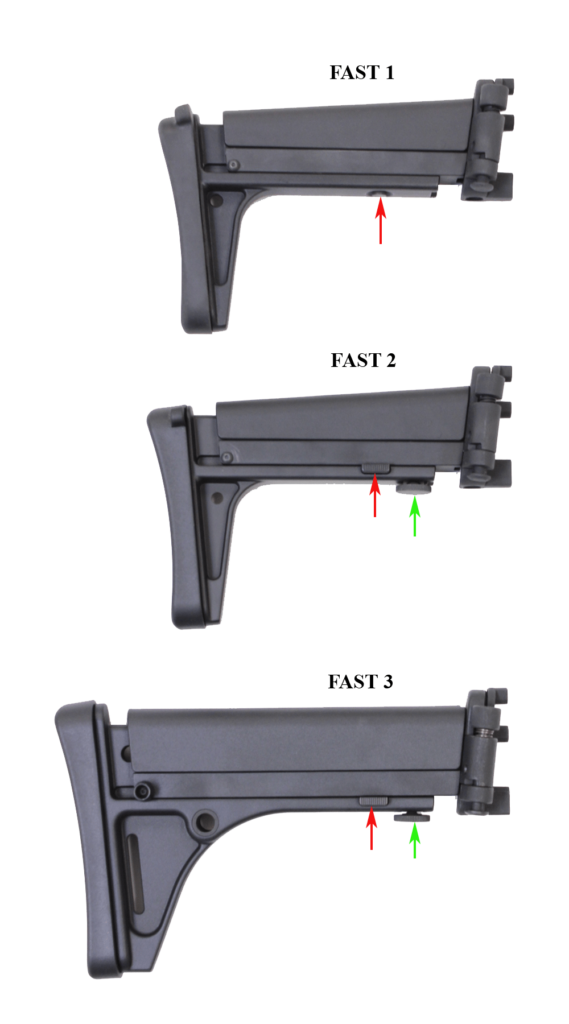
The FAST(TM) 1 is a very compact folding and length adjustable stock. It fits all XCR models. It can be adjusted for length from a 10″ Length of Pull (LOP) to a 13″ LOP. The length of the stock is controlled by a button on the bottom indicated by the red arrow that allows the butt to slide and be locked into various lengths. The FAST(TM) 1 has an two position adjustable cheek rest. The height of the stock can also be adjusted by unbolting the stock from the folding hinge and bolting it on at various heights. The hinge is steel with a QD sling mount hole on the bottom. All its structural components are aluminum or steel rather than plastic.
The FAST(TM) 2 is the same size and shape of the FAST(TM) 1 but the length adjustment button on the bottom has been replaced two small buttons indicated by the red arrow on opposite sides of the stock. These buttons must be depressed simultaneously to adjust the stock length. In addition to the length adjustment buttons, there is a dial indicated by the green arrow on the bottom of the stock. This dial allows the sliding part of the stock to be firmly tightened so that there is no slop in the sliding parts of the stock.
The FAST(TM) 3 fits all XCR-L and XCR-M models. It folds, is adjustable for length, and is made from similar materials as the FAST(TM) 1 and 2. However, It has a LOP from 13″ to almost 17″ which, like the FAST(TM) 2, is adjustable via two small buttons (indicated by the red arrow) on opposite sides of the stock which must be depressed simultaneously. In addition to the length adjustment buttons, there is a dial indicated by a green arrow on the bottom of the stock. This dial allows the sliding part of the stock to be firmly tightened so that there is no slop in the sliding parts of the stock. The FAST(TM) 3 also has a longer straight cheek rest which has three positions for height adjustment. Its height may also be adjusted by bolting the stock at different heights to the hinge. It also has two additional QD sling mount holes on each side of the stock. This stock is truly comfortable and has all the adjustments target stocks do without the size, weight, and complexity.
XCR STOCK HINGES
There are two version of the XCR Folding Stock Hinges. Please refer to the images below.
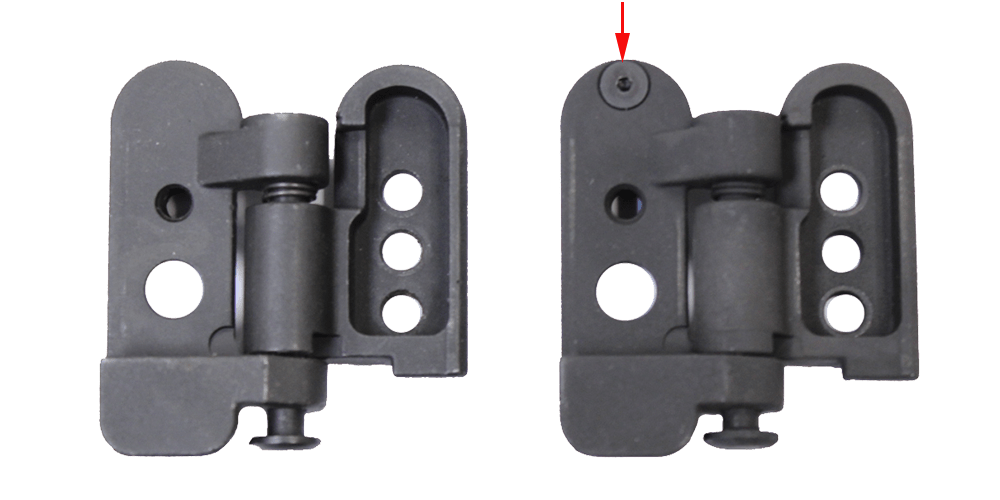
The hinge on the left side is an older model. The one on the right is a newer model and is distinguished by screw indicated by the red arrow. The screw can be screwed in or out. Its purpose is to take up any wobble in the folding mechanism when the stock is deployed. Don’t fret if you have the older model. There’s a way to take the slop out of it also Contact us for more information.
XCR STOCK ADAPTERS
In addition to the stocks, we offer a Pistol Cap and other stock adapters. Please refer to the image below.
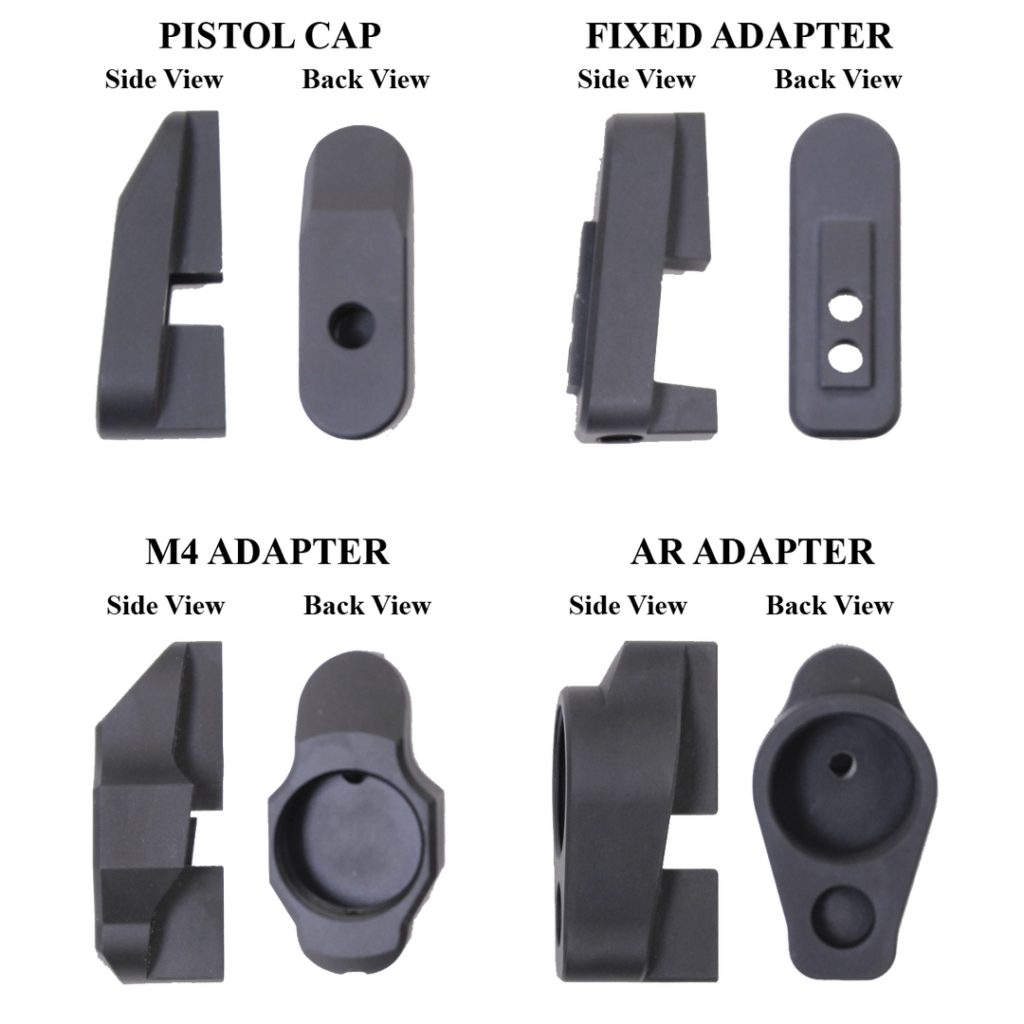
The Pistol Cap is used instead of a stock to make an XCR Pistol. It bolts on in place of the stock. It has a QD sling swivel mounting hole on its back.
The Fixed Adapter is used in place of the hinge with the FAST(TM) 1 and 3 Stocks. This adapter does not allow the stock to fold.
The M4 Adapter is used to attach M4 type stocks to an XCR. The Tube of the M4 stock is mounted lower in relation to its height if mounted on an M4. It does not use the tear drop shaped plate that prevents rotation of the stock tube; rather it uses a set screw for this purpose.
The AR Adapter can accept almost any AR15 stock. The stock’s tube position is roughly the same height as the tube when used on an AR15 thus maintaining the cheek to sight height found on an AR15.
XCR Brass Deflectors
Below are the various Brass Deflectors that have been shipped with XCR Rifles and Conversion kits.
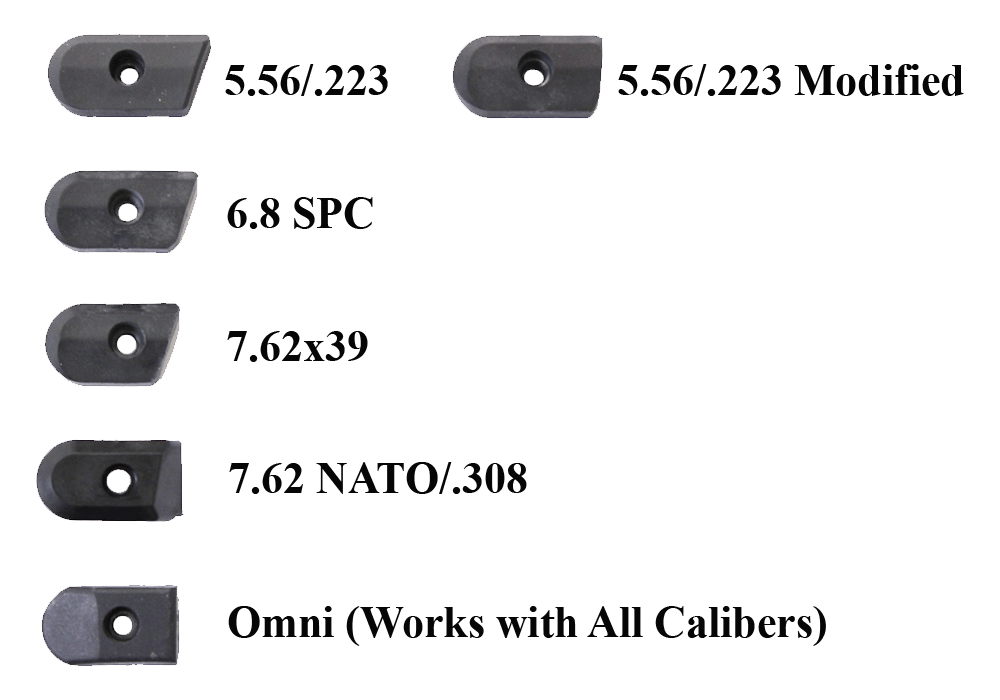
In the past there was a separate Brass Deflector for each caliber. In some cases, using the wrong brass deflector caused malfunctions. The “Omni” deflector shown on the bottom not only works well with all calibers but often allows the operator to run the firearm at a much lower gas setting resulting in a lower recoil impulse without sacrificing reliability. This is very important improvement and highly recommended for any serious XCR user.